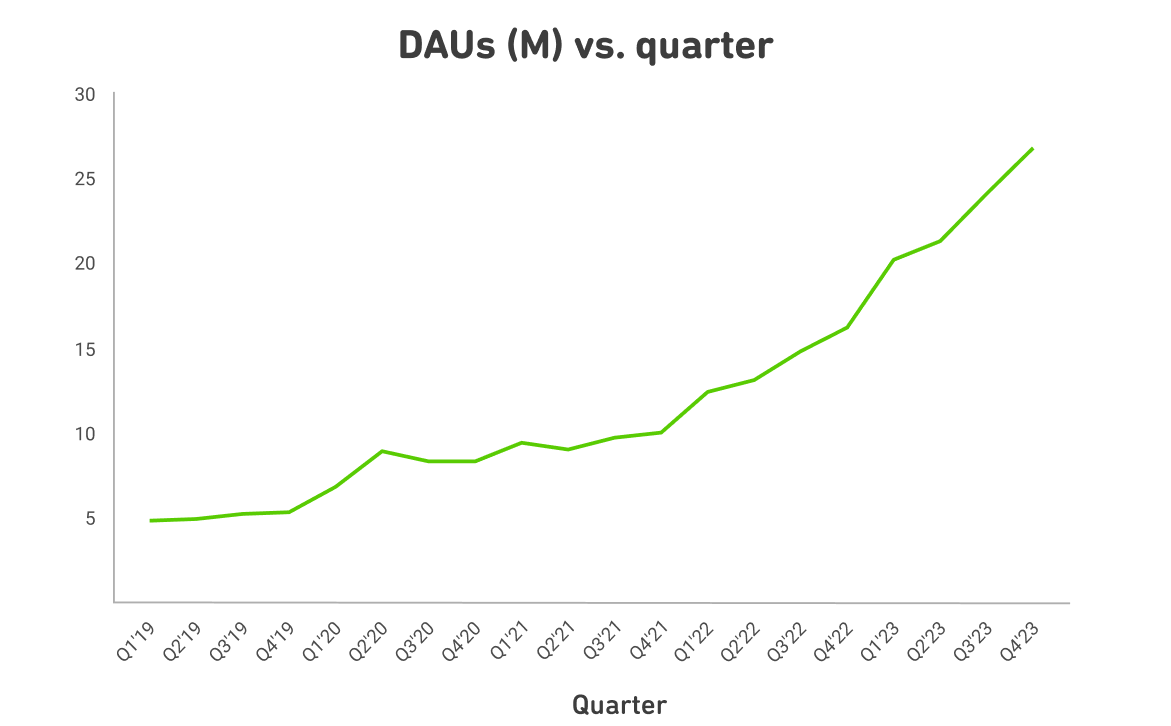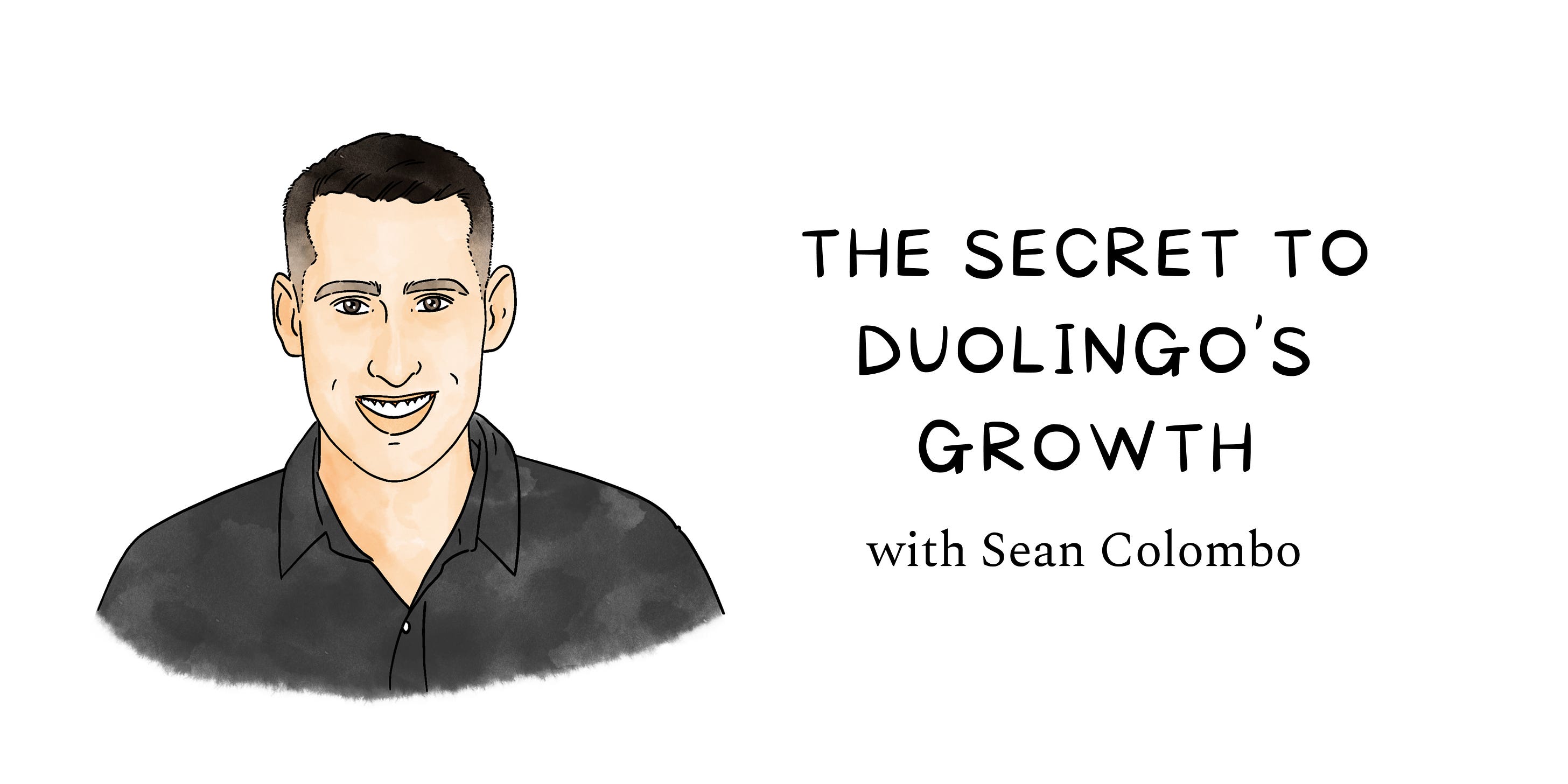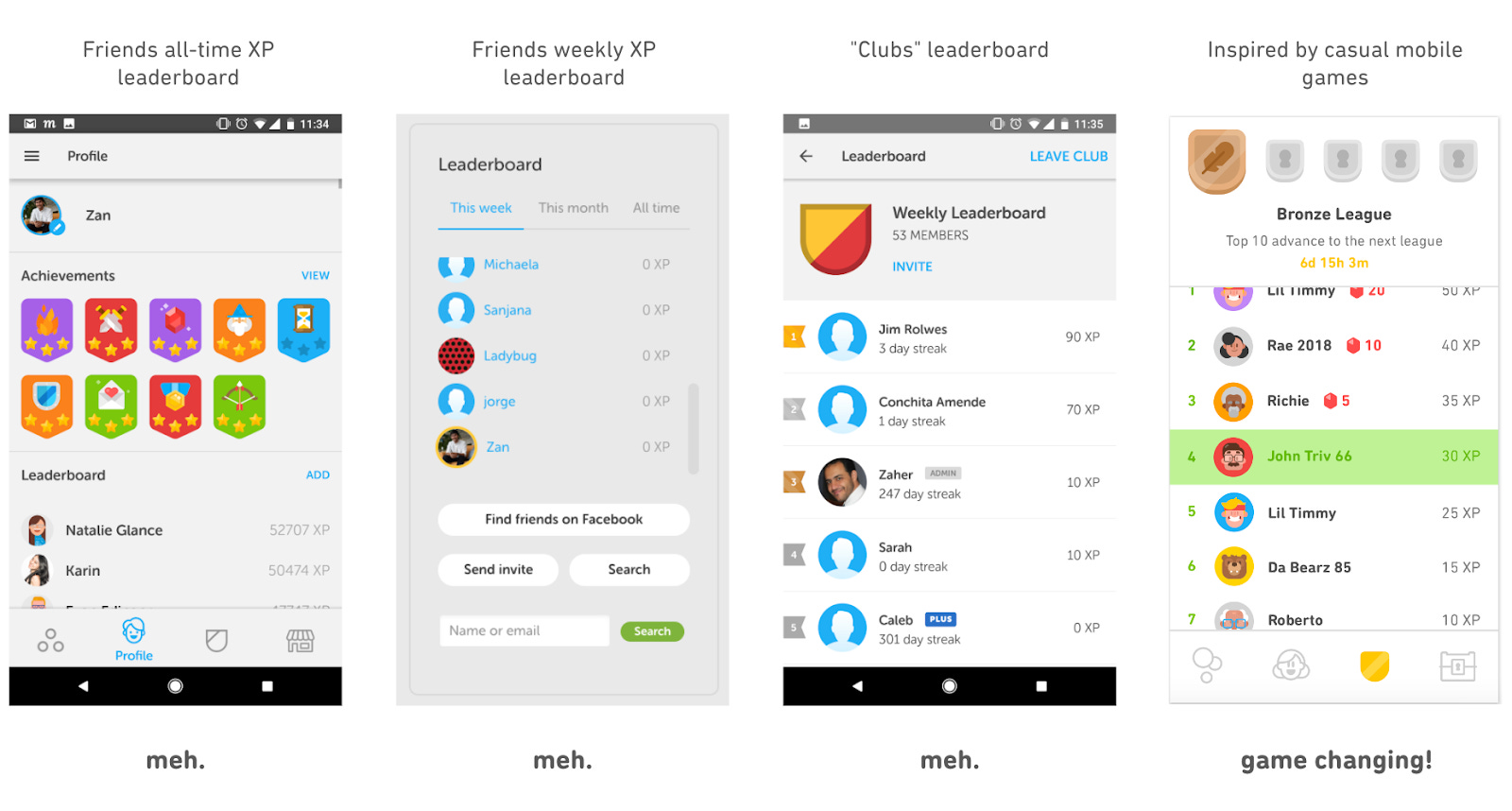The secret to Duolingo’s growthDon’t kill the golden goose, maintain a sense of urgency to drive compounding growth, copy first, and more of their biggest growth lessons👋 Hey, I’m Lenny and welcome to a 🔒 subscriber-only edition 🔒 of my weekly newsletter. Each week I tackle reader questions about building product, driving growth, and accelerating your career. P.S. Check out my recruiting service (helping you hire Sr. PMs and VPs of Product), Lennybot (an AI chatbot trained on my newsletter posts, podcast interviews, and more), and my swag store (great gifts for your favorite PM, or yourself!) “How Duolingo reignited user growth,” by Jorge Mazal, is my #1 most popular post of all time. But the story didn’t end there. Growth at Duolingo has continued to go exponential, and VP of Engineering Sean Colombo has been there through it all. In the past five years, Sean’s team has grown Duolingo’s daily active users from 5 million to nearly 30 million today (over 6x!), and the stock has nearly 3x’d in the past two years, largely thanks to methodical product iteration and experimentation. This re-acceleration is something you almost never see at a company that’s over a decade old, especially after a multi-year deceleration. In this post, Sean shares five of his biggest growth lessons over these five years at Duolingo. If you’re looking for ideas and strategies to drive your own product’s growth, this post is for you. For more from Sean, follow him on LinkedIn. When we were bringing all our Growth teams under one org, I made an internal doc called “Colombo’s Musings on Growth” with some opinions on what I felt was driving our massive re-accelerated growth over the past few years and how we could keep up the momentum. The doc seemed to resonate well with my fellow Duos, and so this post is an attempt to share several of these musings with a larger audience—a continuation of Jorge’s post, in a way. It covers both strategic and tactical things that we learned during the growth we’ve sustained for over five years. 1. 📈 Maintain a sense of urgency to drive compound growthOne of the core things we’ve learned is that a sense of urgency leads to compounding growth. To get the best long-term gains, you should always have a sense of urgency. The quicker you launch winning experiments, the quicker those changes impact your growth. Not only that, but these improvements compound! An exampleSay you have 100,000 DAUs and a retention rate of 80%, and for every five users, one of them tells a friend each day to download your app (and they do it). You get 20k new users per day just from word of mouth. In this equation, Xn is the number of DAUs today and Xn+1 is the number of DAUs tomorrow:
If you start with Xn = 100,000 DAUs, you’ll notice that the next day’s value (Xn+1) remains 100,000 DAUs—an equal number of users join and churn each day.
You’ll notice that between Sunday and Monday the first week, we added 1,000 DAUs. One week later we added 1,072 DAUs that day because there were more users to spread the word. Whatever experiment it was that resulted in this 1% gain to retention is already adding 72 more people each day just because it was launched one week prior. After two or three weeks, the effect continues to grow compared to that first day. At Duolingo we launch hundreds of experiments per quarter, so this type of impact can really add up. OK, so compound growth is great, but how does this tie in with a sense of urgency at Duolingo? We run experiments on almost everything we do, and launching these experiments quickly has a meaningful impact on our long-term success.
To ensure that we’re moving quickly and striving for growth without sacrificing quality, we use these guidelines that you can also apply at your org:
Of course, many reasonable people (and companies) gather as much data as possible, wait to launch until things are perfect, and expose experiments to only a small number of users for a long time. And these companies can also succeed. However, our experience at Duolingo has shown me that our approach works very well over the long term. Keeping a sense of urgency leads to fantastic compound growth. If the concept of urgency resonates with you and you want to take it to an entirely new level, it’s worth reading Frank Slootman’s book Amp It Up or his LinkedIn article to get a shorter version of his ideas. 2. ♟️ Identify your strategic advantageFinding your strategic advantage can be really helpful in guiding your product strategy. At Duolingo, our strategic advantage is that our users want to build a habit. Our CEO, Luis von Ahn, has said many times that our competition might actually be Instagram, TikTok, and other ways for people to just pass the time on their phones. While social networking and games have their own advantages, we have one that those other apps don’t: our learners want to build a habit on Duolingo. Nobody downloads Royal Match thinking, “I hope I keep up playing this game for hours each day.” But our users have a conscious desire to learn another language, so they’re a partner in our goal to retain them. This strategic advantage plays out well in a number of ways. One especially important thing I’ve learned is that if we give users useful notifications (with an easy way to turn them off for those who don’t find them valuable), those tend to be well-received. Please note that this doesn’t mean we should spam users. (See the section below on notifications and the golden goose.) The best book I’ve read about strategy is Good Strategy/Bad Strategy by Richard Rumelt. Conveniently, the author was also on Lenny’s Podcast recently discussing strategy. Check it out! While it’s definitely worth reading the whole book, a very short explanation of how to find your strategic advantage would be:
Our learners wanting to build a habit gives us an advantage over other ways they could spend their time. We built on that advantage, and now we have a sustainable lead over language learning apps and other learning apps, too. For us, identifying our strategic advantage pointed us toward iterating on notifications and the streak system (which helps build the habit that our users want to build). When you find your strategic advantage, it will point you in the direction of product changes that should have outsize results for your business. First, read the Rumelt book mentioned above, figure out your strategic advantage, and then use it to home in on actionable product changes. 3. Copy first, then innovate🚲 Don’t reinvent the wheel when it comes to app mechanicsThere are literally millions of mobile apps, and the biggest of them have billions of users. The larger ones have run A/B tests with a combined total of billions of treatments. Furthermore, the app marketplace itself could be seen as a genetic algorithm where winning concepts end up with more users, which means they inspire the next set of app developers, and so on. This means that if you would like to use a concept that’s already widespread in the industry, your first approach should be to start with a system that closely resembles an existing successful one, but adapted to your app. A great example for Duolingo was our leaderboards. Many apps, especially casual mobile games, have excellent leaderboards. They’ve spent tons of time refining them, so we rightly assumed we could find a version of these that was effective for us, too. Our current leaderboard system was our fourth iteration, but it blew away our prior attempts. We based it heavily on successful leaderboards in other games such as Gardenscapes, Golf Clash, Toon Blast, and more. The winning leaderboard for us (our fourth iteration) was an opt-out experience that put people in a new group of 30 each week, where a number of people get promoted or demoted to higher or lower leagues each week. The leagues automatically tuned people to be with others of a similar difficulty. Along with rewards for the top three places, this created several different interesting boundaries in the group of 30, where many users are always close to either gaining or losing something based on their position. It took a ton of great product and design work to adapt these ideas to fit in Duolingo. Our leaderboard system was the most complicated feature we’d added to Duolingo, but we had to make sure that people could figure it out without pop-up explainers. But it was worth the effort: D1 retention went up 1%, D7 retention went up 2%, and D14 retention went up 3%. Additionally, the time people spent learning increased by around 17%, which was an absolutely amazing result for us—typically if our experiments can move a major metric by 1%, that’s a really good outcome. These sorts of lessons can be applied to many other very common game mechanics that work well in some apps and platforms and poorly in others. For example: achievements, quests, badges, cosmetics. I even think Duolingo could often do better at following our own advice. Your first minimum viable product (MVP) version of an existing, widespread mechanic is not the time to get clever and innovative. 💡 When should we innovate?There are two scenarios where I think you should try to be clever and start to push the envelope:
4. 🦢 Notifications are the goose that lays the golden eggs—don’t kill the gooseThis won’t apply to all apps, but at Duolingo, notifications have been a source of continued small-to-medium wins year after year, with no obvious signs of slowing down.
Some things we do at Duolingo to avoid killing the goose:
 Continue reading this post for free, courtesy of Lenny Rachitsky.A subscription gets you:
|
Search thousands of free JavaScript snippets that you can quickly copy and paste into your web pages. Get free JavaScript tutorials, references, code, menus, calendars, popup windows, games, and much more.
The secret to Duolingo’s growth
Subscribe to:
Post Comments (Atom)
Top 3 UX Design Articles of 2024 to Remember
Based on most subscriptions ͏ ͏ ͏ ͏ ͏ ͏ ͏ ͏ ͏ ͏ ͏ ͏ ͏ ͏ ͏ ͏ ...
-
code.gs // 1. Enter sheet name where data is to be written below var SHEET_NAME = "Sheet1" ; // 2. Run > setup // // 3....






No comments:
Post a Comment